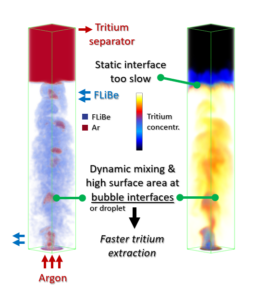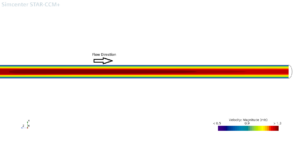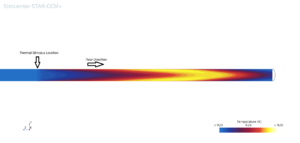Research
Nuclear power will play a crucial role in the future by supporting carbon emission reduction goals, lowering the levelized cost of electricity (LCOE), and enhancing energy diversity and security. However, while the affordability of renewables continues to improve, the high capital costs of nuclear remain a significant barrier to its expansion. Traditionally, nuclear power has served primarily as a baseload energy source but as the power grid incorporates more variable demands and energy sources, nuclear needs to evolve beyond its conventional role to survive in the competitive market. Current reactor designs lack the flexibility to efficiently respond to fluctuating demand. They experience substantial heat losses during periods of low demand and are unable to ramp up quickly to accommodate demand surges. Addressing these limitations will be critical for nuclear energy to remain a competitive and adaptable component of the future energy mix.
Thermal energy storage (TES) presents a convenient, cost-effective, and direct method for storing energy produced by nuclear reactors. Integrating reactors with TES systems can effectively enhance economics and system flexibility, while minimizing the need to change the reactor design and operation mode. TES systems serve as dispatchable energy buffers that decouple the nuclear reactors from the power conversion block and thus the grid. Consequently, nuclear reactors can comfortably operate under constant power, while the power plants’ outputs can be easily varied according to the market needs.
To improve thermal energy storage performance in nuclear systems, one promising approach is the use of latent heat from phase change materials (PCMs). By leveraging latent heat, PCMs enable efficient energy storage while largely reducing system volume and maintaining a stable temperature during energy charging and discharging. This makes them an attractive solution for improving the adaptability and efficiency of future nuclear power systems.
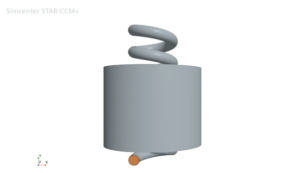
Figure 1: Helical Coil Design of Latent Heat Storage System. (PCM is located within the cylinder, and the heat transfer fluid flows through the coil.)
The aim of this project is to design a novel latent heat energy storage system pairable with advanced reactor systems. In order to meet this goal there are three main focuses:
1. Design a system that can be integrated with an advanced reactor at full scale.
2. Perform scaling analysis on this system to reduce its size and simulate its performance using STAR-CCM+.
3. Create an experiment based on CFD simulations to validate the model's findings.
Additional work includes studying the cyclical behavior of phase change materials in addition to finding new phase change materials with optimal melting temperatures and high latent heat.
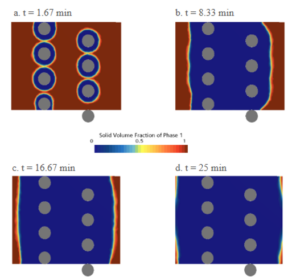
Figure 2: 2-D Slice of Figure 1 Representing the Progression of the Melt Front Over Time in a STAR-CCM+ Simulation
New fission designs will flow molten salt through the reactor core, where tritium will be developed from the lithium component of the molten salt. Tritium is dangerous because of its high activity and ease of diffusion through pipes, and it needs to be continually removed to prevent it from escaping into the environment. On the other hand, fusion systems need to renew their tritium fuel supply by producing it in a closed cycle in their reactor.
Tritium extraction is thus a universal challenge in advancing all types of nuclear power. The main proposed extractor concepts are membrane extractors (permeator-against-vacuum, or PAV), which use Group V metals such as vanadium or palladium with high hydrogen dissociation and diffusion, and gas-liquid contactors (GLCs) which leverage two-phase dynamic mixing to supercharge the mass transfer of tritium.
Figure 1: Argon Bubbling up Through FLiBe Salt to Separate Tritium (Left).Static Interface without Argon Bubbling (Right).
The HEAT Lab's tritium extraction research revisits gas-liquid contactors in a new decade, where significant advances in simulation technology allow us to quickly explore many deficiencies in previous designs. In theory GLCs should be capable of achieving more surface area than PAVs with small enough bubbles, but bubble coalescence has been a major challenge. Our lab has identified superior geometries that can do a much better job maximizing surface area and circulation, and are also interested in the spray regime (liquid in gas, rather than the bubble regime of gas in liquid) which remains mostly unexplored. Very little tritium extraction work has been done with FLiBe specifically, which is also a literature gap we hope to fill. We plan to explore these venues of improvement via both simulation and experiment.
Research
Figure 2: Argon Gas-Liquid Contactor Tritium Extraction Simulation in OpenFOAM
In recent years, the development of advanced nuclear energy systems operating at increasingly high temperatures has presented an energy-efficient alternative to lower-temperature predecessors. These systems are characterized by their use of high temperature heat transfer fluids as alternatives to water. An example of this is molten salt reactors and their maximum operating temperatures can go far beyond 600 °C. Precise and detailed measurements of the molten salt distributed temperature profiles and flow profiles are crucial for understanding the local heat transfer processes.
Unfortunately, commercially-available technology is unable to meet this demand. Thermocouples have an unwieldy setup and poor spatial resolution and flowmeters struggle to provide accurate readings in molten salts due to high temperature, high viscosity, and corrosiveness. One promising approach is the use of fiber optic temperature sensors. These sensors demonstrate high spatial and temporal resolution and easy installation. Additionally the fiber itself is a ceramic material allowing for expansive temperature and corrosion resistance.
Although the fiber itself is resistant often the coatings and manufacturing techniques mean the fibers are only resilient below 300 °C. Additionally, the fibers directly sample temperature but they do not have a direct way of sampling flow measurement.
In order to create temperature resistant sensors we are trying to streamline a process of coating stripping and termination of the sensors in order to take advantage of the resistant ceramic interior. For flow measurement our proposed approach is to create a thermal stimulus at a known distance upstream from the fiber optic cable and measure the time it takes for the pulse to reach the sensor in order to calculate a radial velocity profile of the flow.
The work involved is as follows:
- Make a CFD model of the pipe, sensor, and thermal stimulus configuration to predict the behavior of this system.
- Create a reliable sensor manufacturing procedure to enable high temperature data collection.
- Construct an experimental setup of the fiber and heater for use in our molten salt loop to validate the model predictions.
- Use initial experimental data to train a machine learning algorithm to enable non-intrusive flow profile measurement via pipe wall heating and temperature measurement.
Figure 1: STAR-CCM+ Simulation Showing Molten Salt Flow Velocity in Pipe
Figure 2: STAR-CCM+ Simulation Showing Temperature Distribution in Molten Salt Flow
Preliminary work on this project conducted so far:
The setup of the simulation to conduct a parametric study to inform future experimental setup. Variables of focus include: probe distance (from the heat source), thermal agitation frequency of the heat source, and the salt velocity magnitude.
Additionally, we have created a manufacturing process to create high temperature fiber sensors including mechanical stripping of the coating and angled cleaving to terminate the light signal at the end of the fiber.
We are preparing the database for training an interactive ML algorithm to explore new phase change materials to be used as thermal energy storage media. Our goal is to use one of the scientific material property search engines, e.g., Matminer, to pull physics descriptors from existing material databases.
